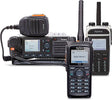
What Is The Difference Between A Two-Way Radio And A Walkie Talkie?
, by Joseph Gabriel, 4 min reading time

, by Joseph Gabriel, 4 min reading time
In the United States, the terms two-way radio and walkie talkie are often used interchangeably despite being different. A two-way radio operates in two different ways.
This is by receiving and transmitting a radio signal and operating in full-duplex or half-duplex mode. Full-duplex mode enables the radio to receive and transmit simultaneously. Half-duplex mode enables the radio to receive and transmit but not at the same time.
A walkie talkie is a handheld, two-way portable radio. The (HT) handheld transceiver enables you to talk on the radio while walking. This is the reason it is called a walkie talkie.
A walkie talkie is always a 2-way radio although a 2-way radio is not always a walkie talkie. There are numerous radios that are not handheld or portable such as a mobile radio that has been mounted on a base station or desk or in a vehicle.

The frequency range of a two-way radio is between 900 MHZ and 150MHZ. The frequency usually travels in a straight line. Radio signals can pass through obstructions, walls and non-metallic objects.
All radio waves can bounce off or be reflected by surfaces. This means the line is not always straightforward. To determine the range, the Earth's curvature and the antenna height must be considered.

A good example is a two-way radio with no obstructions and a six-foot antenna. The communication distance is between four and six miles.
The range of a 2-way radio is affected by obstructions, the frequency used and the weather. The power output is another factor. This is measured using watts.
A handheld two-way radio generally broadcasts at 50,000 watts or 100,000 watts. A 2-way radio with more watts can transmit a greater distance. The additional watts help bypass any resistance.
Watts are not always a benefit for handheld radios powered by batteries because the batteries will run down faster.
The frequency is also a factor for how far a 2-way radio can transmit. The majority of 2-way radios are either (VHF) very high frequency or (UHF) ultra-high frequency. One frequency is not better than the other.

They both have advantages and disadvantages. The best two-way radio for your needs is dependent on your application. The communication between the radios is through radio waves. Each specific frequency offers a different signal.
The transmission of radio waves is in continuous cycles. The frequency of the radio is indicated by Hz or hertz. This is the same as one cycle each second. Kilohertz (kHz) is used for measuring radio waves.
When there are 1000 kHz, it is the same as 1,000,000 cycles each second. The term wavelength was popular when radios were new.
This measured the frequency using the distance between the consecutive cycles of the peaks as opposed to how many cycles each second. A longer wavelength is produced by lower frequencies.
The wavelength for two-way radios is significant because certain conditions can impact the transmission range. In most instances, a longer wavelength can travel farther. Longer wavelengths or lower frequencies have more penetration power. This is why submarines use them for communication.
Very low frequency (VLF) radio waves can penetrate to roughly a twenty-meter depth in seawater. This means they can be used by a submarine in a shallower depth.

Even though a 2-way VHF radio can travel farther and uses a lower frequency, it is not necessarily the better choice in buildings. The transmission distance is significantly impacted by the wavelength.
If you are communicating on one side of a metal building to someone on the other side, your transmission distance will be affected by metal walls. Radio waves will not usually pass through metal.
Microwaves are a good example. The metal mesh on the glass door has very small holes.
Your microwave operates using a very high frequency despite the wavelengths only being a few inches long. The mesh ensures everything remains trapped inside but due to the microscopic wavelength, you can still see the light.
The difference is the challenges faced by a VHF signal. A wireless signal has the ability to penetrate through solid objects such as masonry, furniture, drywall, human bodies and wall paneling.
Every one of these objects will decrease the strength of your signal.
When the object is denser, the signal decreases even more. UHF does not penetrate these obstacles as well as VHF. This does not mean VHF is superior for indoor applications.
The lower frequencies including VHF diffract more easily around big, smooth objects. VHF also travels easier through stone and brick. In most instances, lower radio frequencies work best for a longer range.
This is apparent in a broadcasting television station. The average VHF station has a coverage area of approximately sixty miles and uses around 100,000 watts. To cover the same sixty miles, a UHF station will require 3,000,000 watts for transmitting.
Visit our store if you would like to see a variety of models we carry. --> Click Here